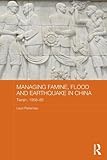Managing Famine, Flood and Earthquake in China Tianjin, 1958-85
Language: English Publication details: Oxford Routledge 20151005Edition: 1Description: 228 pISBN:- 9781317567462
China suffers frequently from many types of natural disasters, which have affected the lives of many millions of Chinese. The steps which the Chinese state has taken to prevent disasters, mitigate their consequences, and reconstruct in the aftermath of disasters are therefore key issues. This book examines the single metropolis of Tianjin in northern China, a city which has suffered particularly badly from natural disasters – the great famine of 1958-61, the great flood of 1963 and the great earthquake of 1976. It discusses how the city managed these disasters, what policies and measures were taken to prevent and mitigate disasters, and to promote reconstruction afterwards. It also explores who suffered from and who benefited from the disasters. Overall, the book shows how disaster management was erratic, sometimes managed highly efficiently and in other cases disappointingly delayed and inept. It concludes that, although the Maoist state possessed formidable resources, disaster management was always constrained by other political and economic considerations, and was never an automatic priority.
There are no comments on this title.
